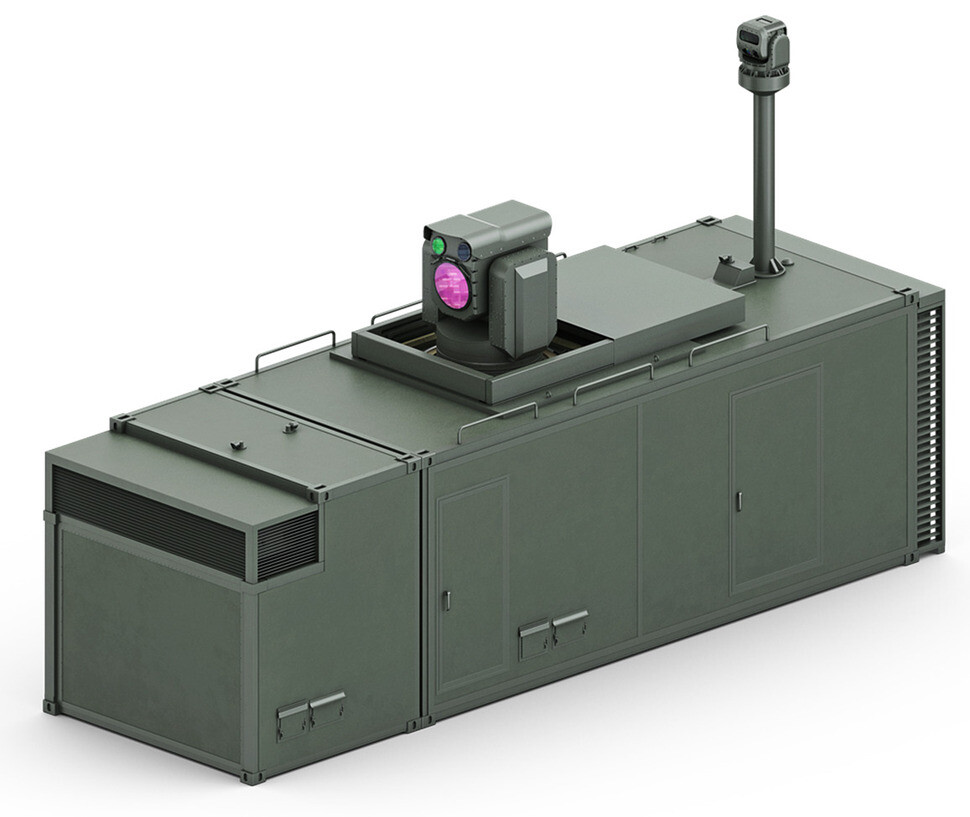hankyoreh
Links to other country sites 다른 나라 사이트 링크
S. Korean Defense Acquisition Program to develop laser antidrone weapon

Amid reports of major damage to key Saudi Arabian petroleum processing facilities and oil fields following a drone attack, the Defense Acquisition Program Administration (DAPA) announced on Sept. 17 that it had begun development on a laser-based antiaircraft weapon for stopping miniature drones used for terrorism, attacks, and unauthorized reconnaissance. The laser antiaircraft weapon is a new concept of weapon system that is capable of close-range precision strikes against small drones and multicopters using a laser produced from optical fibers.
Beginning this year, DAPA plans to invest around 88 billion won (US$73.9 million) in the laser antiaircraft weapon’s development, which is to be supervised by the Agency for Defense Development (ADD) with a target completion date in 2023. ADD has been involved in core technology research to study laser combination for improved output, along with tracking and targeting technology. It has reportedly acquired the core technology needed to aim and fire the laser at its target. South Korean defense companies will reportedly be taking part in the prototype development.
“In addition to not being visible to the eye or accompanied by any noise, the laser antiaircraft weapon can be operated with only a supply of electricity,” DAPA said.
“The cost to fire it one time amounts to only around 2,000 won [US$1.68],” it added.
DAPA also plans to introduce an evolutionary development strategy concept to the laser antiaircraft weapon’s development in order to improve its performance and enable the interception of fighter aircraft and satellites. “Evolutionary development strategy concept” refers to the separation of operational performance targets during weapon system development and repeating the same development stage two or more times.
“No country has yet integrated laser antiaircraft weapons into its military,” said Song Chang-joon, head of DAPA’s guided weapon project division.
“Once development is completed, it will be an opportunity for a big stride forward for South Korea’s defense science and technology,” Song said.
Military authorities have reportedly been examining drone detection, tracking, and attack countermeasures in the wake of the Saudi Arabia attacks. The Capital Defense Command (CDC) recently integrated nine drone defense detection radar units imported from Israel in April. The detection radar reportedly captures drones and neutralizes their frequency to defend key infrastructure in the Greater Seoul area, including the Blue House, National Assembly, and airports.
The military is also developing three-dimensional air defense radar to detect drone altitude in addition to distance and direction. The South Korean Army’s current low-altitude detection radar is limited in its ability to detect small aircraft, while the Air Force’s low-altitude surveillance radar is constrained by the mountainous terrain and broad scope of area to be monitored. The military’s current radar is reportedly unable to capture drones that have wing lengths of over 3m and fly at altitudes of 2 to 3km.
By Yoo Kang-moon, senior staff writer
Please direct comments or questions to [english@hani.co.kr]

Editorial・opinion
![[Editorial] Does Yoon think the Korean public is wrong? [Editorial] Does Yoon think the Korean public is wrong?](https://flexible.img.hani.co.kr/flexible/normal/500/300/imgdb/original/2024/0417/8517133419684774.jpg) [Editorial] Does Yoon think the Korean public is wrong?
[Editorial] Does Yoon think the Korean public is wrong?![[Editorial] As it bolsters its alliance with US, Japan must be accountable for past [Editorial] As it bolsters its alliance with US, Japan must be accountable for past](https://flexible.img.hani.co.kr/flexible/normal/500/300/imgdb/original/2024/0417/6817133413968321.jpg) [Editorial] As it bolsters its alliance with US, Japan must be accountable for past
[Editorial] As it bolsters its alliance with US, Japan must be accountable for past- [Guest essay] Amending the Constitution is Yoon’s key to leaving office in public’s good graces
- [Editorial] 10 years on, lessons of Sewol tragedy must never be forgotten
- [Column] A death blow to Korea’s prosecutor politics
- [Correspondent’s column] The US and the end of Japanese pacifism
- [Guest essay] How Korea turned its trainee doctors into monsters
- [Guest essay] As someone who helped forge Seoul-Moscow ties, their status today troubles me
- [Editorial] Koreans sent a loud and clear message to Yoon
- [Column] In Korea’s midterm elections, it’s time for accountability
Most viewed articles
- 1[Column] The clock is ticking for Korea’s first lady
- 2Samsung barricades office as unionized workers strike for better conditions
- 3[Editorial] When the choice is kids or career, Korea will never overcome birth rate woes
- 4[News analysis] After elections, prosecutorial reform will likely make legislative agenda
- 5S. Korea, Japan reaffirm commitment to strengthening trilateral ties with US
- 6Japan officially says compensation of Korean forced laborers isn’t its responsibility
- 7Why Israel isn’t hitting Iran with immediate retaliation
- 8[Editorial] Does Yoon think the Korean public is wrong?
- 9[Guest essay] How Korea turned its trainee doctors into monsters
- 10[Guest essay] Amending the Constitution is Yoon’s key to leaving office in public’s good graces